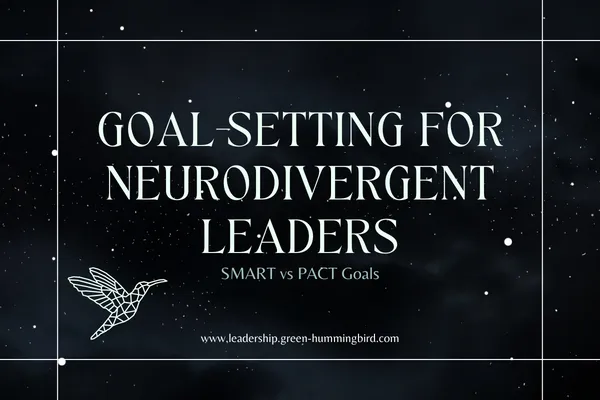
Goal-Setting for Neurodivergent Leaders
With the New Year, it feels like everyone is making Resolutions and setting goals for themselves to accomplish over the next 365 days. I feel like something about my being autistic never really got me into it that much. I would see it as a time to reset after the holidays, sure. But (and maybe this was my ADHD) I never really built new habits starting January 1, just because it was January 1. Maybe deep-down, I always knew time was a social construct? And also, most of those “habits” involved doing things like jogging outside, and I hate jogging, and it’s cold outside in January… so they never lasted after I got sick.
All that is to say, it’s that time of year when people try to build new habits and set goals for their future, but you don’t HAVE to do it now, or at all. If you are interested in setting goals for yourself, or are a leader interested in helping your team set goals, read on!
Setting Goals Stresses Me Out!
I’ve talked about goal-setting for Annual Performance Reviews in most of my content already. In fact, one of the first digital products I created was a Goal Planner, with explanations as to why they’re important, how to come up with goals, and the difference between professional development and productivity goals. When I was rising the ranks, setting goals was so difficult for me, especially as a neurodivergent individual. No one could tell me what they meant for me to do, just that I was doing it wrong. So I wanted to make something that demystified that process for other people like me. Because it wasn’t until I was creating that Goal Planner for others that I realized the difference between personal goals, productivity goals, and professional development goals, and that, at least my boss, was largely asking me to make these goals not to add one more thing to my already over-piled plate, but to get me to think about the future and what kind of improvements I could start working on now. They were not necessarily goals that I needed to accomplish, because they were not productivity goals. But they were something that I was going to try to work toward, maybe in my off-hours, to better myself, and get moving toward my future.
Looking back on it, the fact that my boss at the time was doing that was really nice of her. I don’t think most bosses would bother with trying to help their employees better themselves. Most just want their employees to focus on the bottom line, maybe set productivity goals, and that could put the employees job in danger if they don’t reach those goals. It’s the latter that I expected when I went into those annual performance review meetings to set goals for myself. And already feeling overworked and overwhelmed, I could not think of anything more I could do to improve my productivity… I was already literally making myself sick just to get the work I had to do done on a daily basis. And so it became another stressful thing to deal with every year, as I tried to come up with one more thing that I might be able to do so that I wouldn’t get fired. Of course, since I was already overwhelmed, I couldn’t articulate how hard this whole process was for me, and I think that while my boss picked up on that, she didn’t realize it was because of overwhelm, rather than obstinance, so she would get frustrated with me.
In that job, in particular, most of the metrics of the work we did as individuals came down to whether or not the task got completed on time. With a side helping of whether the people we served got their own improved metrics in other ways. But what we could control was whether or not the thing got done.
Types of Goals
I recently came across the concept of PACT Goals, which you can read about more here. (This article was posted by my former student loan provider, so I’m sure it’s ultimately about how to give them money.) But the point of PACT goals is not to measure out numbers of some kind of improvements. Rather, most of the time the PACT goals are meant to help build habits. So the question is whether or not the task got completed. I think if this type of goal setting option was explained to me back then, especially in conjunction with an explanation that the goals being set were for my own personal benefit, rather than one more thing I needed to tear at my soul to complete, I would have been in a much better headspace in my annual reviews.
Now, in my leadership coaching, most of the time we are working on SMART goals. SMART stands for:
Specific: Simple, sensible, and significant
the 5 W’s-who, what, where, when, and why.
Measurable: Meaningful and motivating
What determines your progress and how will you know when you achieve your goal?
Achievable: Agreed and attainable
Is your goal reachable and what resources do you have to achieve it?
Relevant: Reasonable, realistic, resourced, and results-based
Can you get this done in a specific time frame?
Do you have the resources?
Can you really commit to what you need to hit this goal?
Time Bound: Time-based, time limited, time-sensitive
Does your timeline have clearly defined start and completion dates?
For coaching, this goal model works because I’m there to hold you accountable to accomplishing these goals, and, well, sessions are a lot more boring if all the questions I can ask about it are “did you do it every day since we last spoke? Circle one. Yes or No.”
If you need a specific example to picture this concept of SMART goals, consider what it would be like to go through this list if your goal is to throw a party. Under Specific, you will basically answer all the questions you need to answer on the invitation. Under Measurable, what would make this party successful? Under Achievable, can you actually do it? Do you have the money, space, and/or other resources you need for your party vision to come to fruition? Under Relevant, can you get everything together in time for the selected date? Is this even possible with your own time and energy constraints? Under Time Bound, the party date would be the completion.
SMART goals work best for project-based goals. Projects are typically already all these things. And since everyone seems to use “Goal” to mean different things, but within the same concept, I changed one of the “Goals” to “Quest” (because that’s more fun for me), and made the graphic below to help you see the goal-setting process in one snapshot (and also get a peek into how my brain works).

As you can see, when setting annual goals, I try to have:
a theme for the year (so, this year, my theme is “Progress over Perfection”)
a Quest (sometimes people call this “goal”) that lasts about 90 days (currently: “Be more visible”)
2 or more goals to help with that quest (So I’m 1. Launching a mini-membership, 2. Hosting masterclasses, and 3. Putting my face on social media more.)
I know I’m not enumerating how they are SMART here, but you’ll see more in the following steps.
For each of those goals, I break them into smaller projects. (ex: for social media, I want to add my picture to my posts at least 3 times a month and I’m getting back into the TikTok account I abandoned 4 months ago)
For each project, I break them further down into tasks (ex: for TikTok, I am learning how to edit in Capcut, and then I need to record a bunch of clips, and I need to add them to my social media scheduler, so I don’t have to be “ON” every day!)
This example is clearly for my business ventures (yay, marketing), but this system works for just about anything. AND even the theme and the quest have inspired me in other parts of my life. “Progress Over Perfection” rolls around my head a lot when I’m having a bad brain day. It helps me to have grace with myself. And “Be More Visible” has already gotten me out and social when I really didn’t want to be.
But I think most personal development goals that we, as ND individuals, would really benefit from trying to make for ourselves, are PACT goals. PACT stands for:
Purposeful: Meaningful, long-term, and aligns with your passion
Does this fit with your long-term goals/quest?
Actionable: Based on outputs and the actions taken to achieve it
Would you rather take action today than over-plan tomorrow?
Continuous: Consistent actions, simple and repeatable
What actions can you take that will help you achieve your goal?
Trackable: More of a “yes” or “no” approach, not measurable
Have you done the thing today? Yes or no? This makes your progress easy to track.
In so many ways, accomplishing goals, like good leadership, requires showing up consistently. I’m much more likely to show up regularly and consistently if I am motivated by the purpose of this action that needs to be taken consistently. And tracking our progress with a yes or no is much less stressful than having to write down specific measurements on a regular basis.
It’s way harder for ADHDers to build habits. Pretty much everything we do has to be a conscious thought. It can be exhausting. So this type of goal setting, written down, can really help us, especially. It relieves the stress of falling behind (as we tend to do sometimes), and is overall better for long-term goals, like habit-building.
So, for example, I have been using an app for a couple months to help me remember to do things I need to do every day (get dressed, brush my teeth, drink enough water, do the dishes, etc.) Most days it’s not a huge issue to get these things done. But some days I’m just not having any of it, and I need the motivation to get out of bed. This app has gamified (think 16-bit, DND inspired, slay-the-monster type game) completing each thing on my list. If I don’t get to all of them, it’s okay (just dings my health a little bit for each one). But I don’t want to ignore them all and stay in bed all day either. The app allows me to choose what tasks I put on there and how often they need to be done. And every day, literally all I have to do is check off that I’ve done them. (BTW, there are several apps that do this, but the one I decided to try is called Habitica, available in the App Store and Google Play. I do not get any kickback from them or anything, just letting you know what’s worked for me for about 2 months so far.)
So… Which Should I Use???
So, ultimately, I think that when it comes to short term projects and productivity goals, SMART goals are the way to go. But if you are working on building habits, or something that requires you to be present and show up on a regular basis, typically for a long period of time, PACT goals could work better for you! Really though, it’s all what works best for your brain and helps you the most without stressing you out unnecessarily.
Check out the graphic below, which was available in the article I linked above, to have a quick visual about the difference between SMART and PACT goals and their functions.



